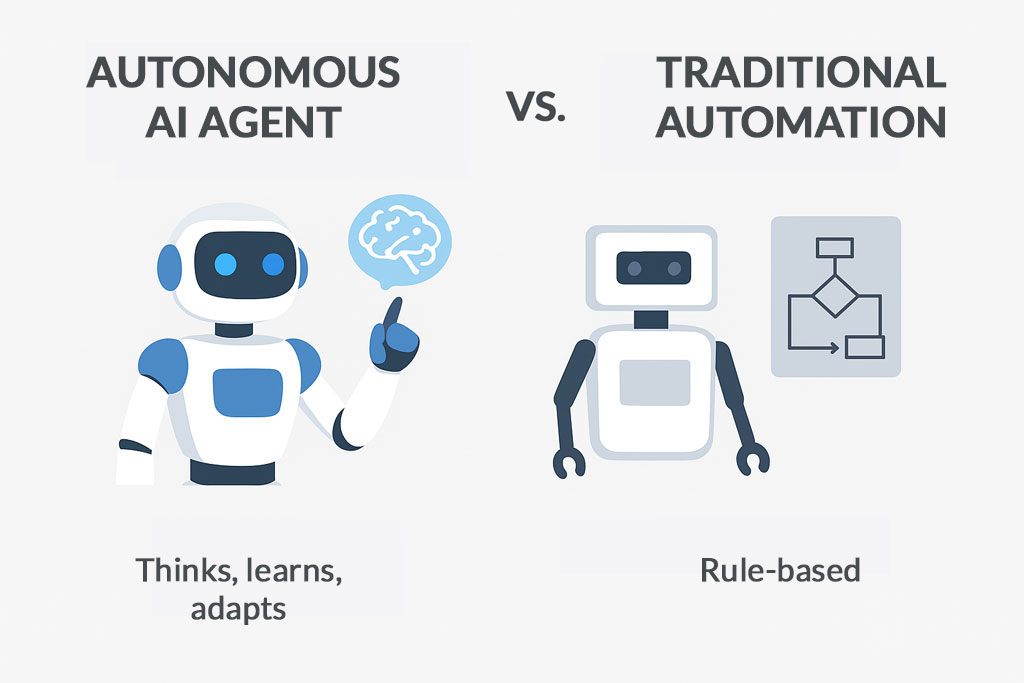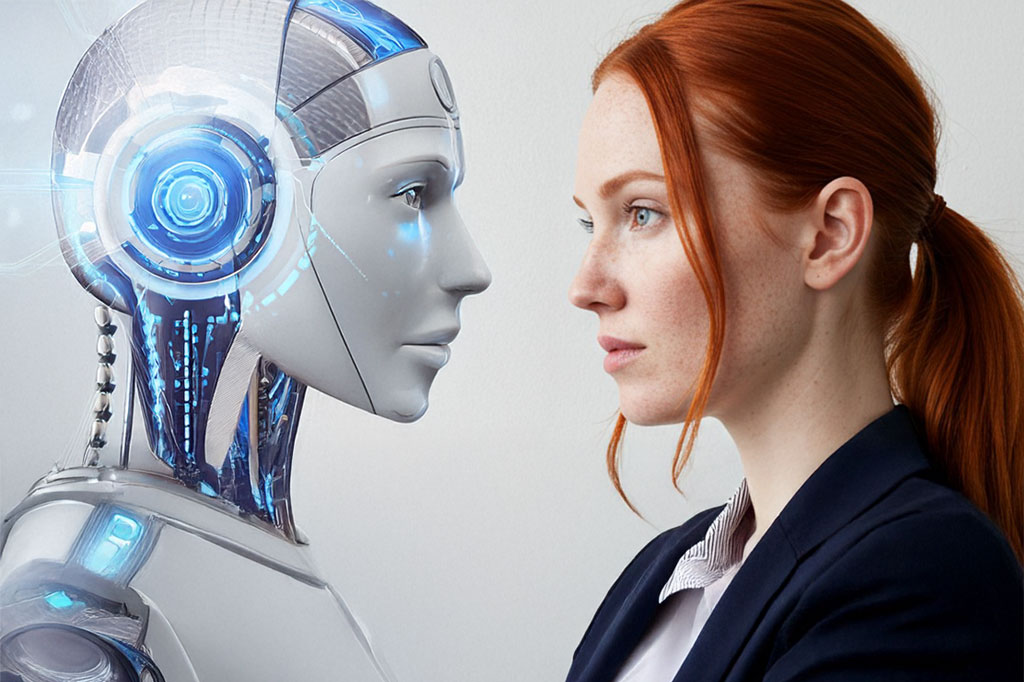
AI Agent vs. Automation
What Is an Autonomous AI Agent?
What is an autonomous AI agent and how does it differ from automation? A concrete comparison and a case example from customer service.

AI Agent vs. Automation
What Is an Autonomous AI Agent?
What is an autonomous AI agent and how does it differ from automation? A concrete comparison and a case example from customer service.
An autonomous AI agent is software that understands a goal, analyzes the situation, and makes decisions independently. Unlike traditional automation, which follows fixed rules, an AI agent learns from experience and adapts to changing situations. It uses machine learning to understand context and make well-reasoned decisions.
Automation is no longer what it was ten years ago. While traditional RPA (Robotic Process Automation) follows predefined rules to the letter, autonomous AI agents do something fundamentally different — they think, learn, and adapt.
But what does autonomous AI agent actually mean in practice? And why should every business leader understand the difference between these two technologies?
Traditional Automation: The Rule-Based Task Robot
Traditional automation is based on simple logic: "IF X happens, DO Y." It’s like a digital worker who performs exactly the tasks it’s been taught, nothing more, nothing less.
Typical Examples of Traditional Automation
- Sending an automatic email when a customer places an order
- Transferring data between systems at set intervals
- Saving form data into a database
- Generating a report every Monday morning using the same template
Traditional automation is excellent for repetitive, predictable tasks. It’s fast, reliable, and cost-effective, as long as the environment remains stable.
Limitations of Traditional Automation
The strength of traditional automation lies in its predictability, but that is also its weakness. When a process requires reasoning, judgment, or the ability to adapt to change, rule-based automation struggles. Exceptions and edge cases don’t fit into predefined rules, and even small changes in the environment can break the automation. Moreover, traditional systems don’t understand context or meaning — they follow instructions precisely but don’t know why they’re doing so.
Autonomous AI Agent: The Intelligent Decision-Maker
An autonomous AI agent goes several steps further. It doesn’t just execute instructions, it understands the goal, analyzes the situation, makes decisions, and learns from experience.
Key Characteristics of an Autonomous AI Agent
1. Goal-Oriented The agent is given an objective, not detailed instructions. It decides how best to achieve the goal.
2. Context Awareness The agent analyzes the situation holistically: who the customer is, what their history looks like, how urgent the matter is, and what the business priorities are.
3. Decision-Making Ability It can weigh options, assess risks, and make informed decisions without human intervention.
4. Learning and Adaptation The agent improves with every interaction. It recognizes what works and what doesn’t and adjusts its behavior accordingly.
5. Ability to Use Complex Tools The agent can access various systems, retrieve and combine information, and use it to support its decision-making.

Practical Comparison: Order Processing
Let’s look at a concrete example that highlights the difference.
Traditional Automation
A customer sends an email requesting to change a delivery date. The system detects the keywords order and delivery date. Based on that, it sends an automated response: "Thank you for your message. Our customer service will reply within 1–2 business days." At the same time, it creates a support ticket that goes into a queue waiting for manual handling. The result: the customer gets a generic response, but their issue doesn’t actually progress.
Situation: The customer emails: "I’d like to change the delivery date of my order." Result: The customer receives a generic reply and must wait.
Autonomous AI Agent
A customer sends an email asking to change the delivery date. The autonomous AI agent understands the meaning and context of the message without manual interpretation. It automatically retrieves the customer’s order history, identifies the correct order, and checks the logistics system for alternative delivery dates. The agent evaluates the customer’s priority level — for instance, whether it’s a VIP client or an urgent order. Based on this, it decides whether it can adjust the delivery date autonomously or if human review is required. It then either sends a personalized reply with suggested options or directly updates the order and synchronizes all relevant systems. With every case, the agent learns — which change requests are common and which solutions work best. The result: the customer gets a real solution in minutes, not days.
Situation: The customer emails: "I’d like to change the delivery date of my order." Result: The customer receives a real solution in minutes, not days.
Humans and AI Agents – Better Together
The goal of an autonomous agent is not to replace humans but to free them for more meaningful work. The agent handles routine and straightforward cases, allowing experts to focus on situations that truly require human judgment and creativity. While the agent answers common inquiries, executes repetitive processes, gathers and connects information, and generates preliminary analyses or recommendations, humans can focus on resolving complex issues, managing strategic customer relationships, and improving processes based on agent-generated insights. This creates a partnership where humans and AI complement each other — efficiently and intelligently.

Case: Streamlining Financial Reporting in a Manufacturing Company
A manufacturing company’s finance department struggled with heavy manual reporting processes. Reporting took 60–70 hours per week, and monthly reports were delayed by 3–5 days. The multi-step data collection process from eight different systems led to errors and left little time for strategic analysis.
The company implemented Empirica’s GenBI Dashboard, a flexible ad hoc reporting platform that enables rapid, customized reporting solutions powered by autonomous AI agents. GenBI automates data collection and validation across systems, intelligently detects anomalies, and produces real-time analyses through natural language queries. It also enriches reports with contextual insights that help users understand the meaning and trends behind the numbers.
As a result, the reporting process became significantly more efficient, errors were reduced, and financial experts were able to focus on interpreting data and making strategic decisions.
When Is an Autonomous Agent the Right Choice?
An autonomous AI agent is worth considering when:
- The process requires reasoning — not just mechanical repetition
- The context varies — cases aren’t identical
- Information comes from multiple sources — integrations are needed
- Exceptions are common — flexibility is required
- Learning adds value — the process improves over time
- Speed is a competitive advantage — real-time responsiveness matters
- Human time is valuable — focus belongs on higher-value work
Traditional automation still works best when:
- The process is completely standardized and repetitive
- There are virtually no exceptions
- The rules are clear and stable
- Learning isn’t required
- Cost-efficiency is the only goal
First Steps – How to Get Started
If you recognize processes in your organization where autonomous agents could add value, it’s best to start systematically. We recommend the following path:
1. Map Your Processes Identify where your people spend a lot of time on repetitive yet variable tasks.
2. Prioritize by Impact Choose a pilot process where:
- The volume is high enough for quick ROI
- Data is accessible (integrations possible)
- The business impact is measurable
- The risks are manageable
3. Start Small Don’t try to automate everything at once. Begin with a clearly defined use case and expand as you succeed.
4. Measure and Learn Set clear success metrics and track them carefully. Continuously improve the agent based on data and feedback.
5. Train the Organization Ensure your team understands what the agent can and cannot do. The best results come when humans and agents work seamlessly together.
The Future Is Hybrid
Autonomous AI agents won’t replace traditional automation — they’ll complement it. The most successful organizations of the future will combine:
- Traditional automation for simple, predictable processes
- Autonomous agents for tasks requiring reasoning and adaptation
- Human expertise for creativity and strategic decision-making
Technology evolves quickly, but the core principle remains the same: free people’s time for the work where they create the most value. Autonomous AI agents make this vision a reality — not tomorrow, but today.
Explore Empirica's AI solutions.
Empirica Finland specializes in AI solutions for B2B organizations and has helped companies across industries leverage autonomous agents to enhance their operations.
Want to Explore How Autonomous Agents Could Boost Your Business?
Book a free 30-minute consultation where we’ll identify your biggest improvement opportunities and outline a tailored implementation plan.
Book a Consultation